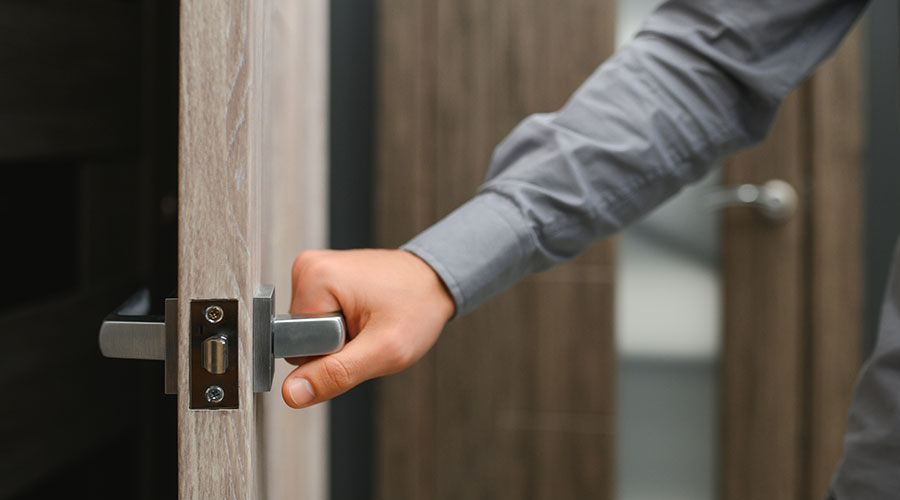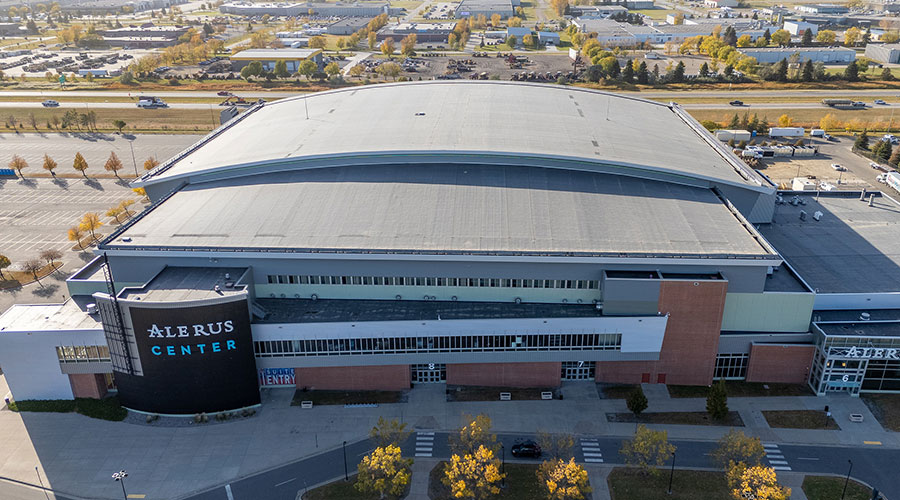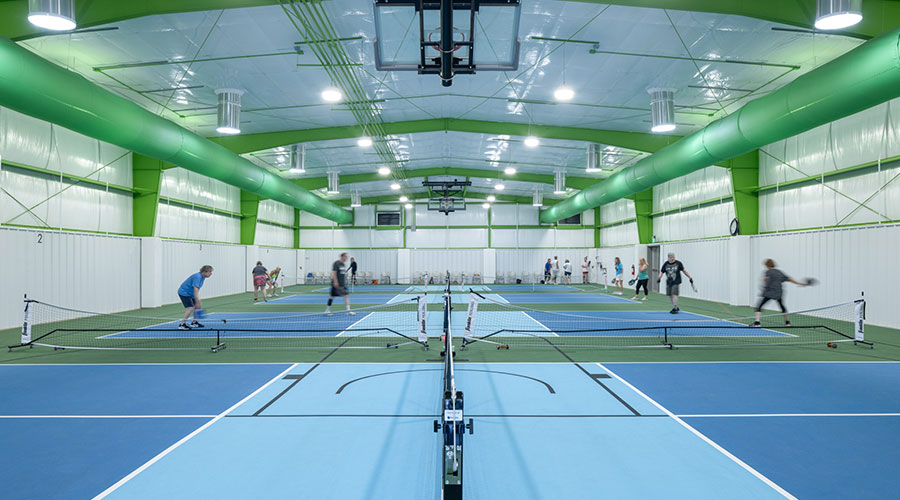
Making Door Hardware Work
Treating door hardware as an essential component of facility security upgrades projects ensures occupant safety. September 19, 2025
By Dan Hounsell, Senior Editor
Ensuring occupant safety in institutional and commercial buildings becomes more critical — and more challenging — each day. As the frequency and severity of threats to facilities increase, pressure is mounting on facility owners and executives responsible for security and occupant safety.
While much of the recent attention related to facility security has focused on such components as visitor management software and metal detectors, one aspect of upgrading facilities with security in mind — door hardware — tends to get overlooked.
“Security in general for commercial and institutional facilities has become a higher priority, whether it’s for safety reasons or protection of assets and property,” says Sean Wicks, assistant vice president for building technology systems with WSP, a consulting engineering firm, adding that facilities “all have different needs, depending on whether it’s a commercial facility, a hospital or an educational facility. But they all typically use the same door hardware. They just may use it differently.”
Changes in products and mindsets
For building owners and executives planning upgrades or retrofits of their facilities’ security systems, recent years have brought changes to door hardware, from locks and handles to card readers and facial recognition technology. Among the most notable changes to door hardware options involves style options now available for critical pieces of door hardware.
“We don’t see a whole lot of changes in the hardware itself,” Wicks says. “There are some changes that they made that actually expanded the offerings” in terms of style options. “You may have had a nice brass finished door front, and all of a sudden you were hanging a stainless steel piece of hardware on it because that was the only option available. Now they’ve started including all of these elements within the various styles that they offer, and the styles pretty much go on forever.”
Perhaps the most important change related to door hardware in recent years is the priority it has become in planning facility security.
“It’s actually changed across just about all markets,” Wicks says, offering education facilities as an example. “Being able to protect students and staff and then in an unfortunate security event, being able to lock facilities down and secure facilities but also allow movement in and out under normal circumstances — that philosophy of security has grown significantly.
“A lot of effort is put into studying how staff and students circulate through a campus and through buildings and what has to be done during an unfortunate security event to protect assets and to protect staff. We look at what door hardware could be used to do most effectively but also not make it cumbersome for normal operations, which is important.”
Ensuring security measures are effective yet not too intrusive is an ongoing challenge.
“If security is inconvenient, it’s not going to be used,” Wicks says. “We have to really look closely and we do that. We leverage a lot of different technologies. We also use things, referred to as crime prevention through environmental design, to create a safe environment.”
Healthcare facilities managers face different yet equally challenging considerations in planning door hardware upgrades to ensure occupant safety.
“It’s a fine line because we will find ourselves in a situation where we know we’ve got to keep it secure,” says Al Murro, assistant vice president, building technology services with WSP, pointing to infant abduction prevention systems. “They’re great systems unless you have an emergency and you need to move an infant from one floor to another. Those systems use bands on the infant — an ankle bracelet or a wrist bracelet. A nurse or a doctor has to get the infant to an elevator, or they’ve got to get to a stair tower. But the system is intended to lock down and not let you through. That’s what it’s designed to do.
“There are a lot of different considerations. We need to secure it to let it work and do its thing every day. But how do we also integrate it so it’s going to allow them to do their jobs?”
Managing the process
To ensure door hardware is selected and integrated into security upgrades effectively and smoothly requires knowledgeable in-house decision makers who work in consultation with designers.
“Generally, if they’ve been long-time building owners and they understand how this all integrates together, that works,” Wicks says. “You have the physical security designer. You have the architect who specs the door hardware. Then you have the client who actually has a keying system, and they understand what hardware they like to use.
“If all three of those don’t work together during the design process, construction becomes very difficult. It becomes very expensive, too, because now you have to make these changes during the construction process, and it’s easier obviously to do it during the design process.”
Murro also emphasizes the importance of conducting a final review of door hardware issues near the completion of an upgrade or retrofit project.
“We always sit down and take a look at it because you have a lot of moving parts,” he says. “We’ve always set that time aside to sit down with architecture to go through it and make sure that we were in sync.
“Almost every project goes through some sort of value engineering. It’s no different than anything else. Security and door hardware have to work together. That final check, that final integration and that back-check has become more prevalent in the last decade than it was in the past.”
Making it work
An effective upgrade targeting facility security and door hardware does not stop with the end of the project. Building owners also need to pay close attention to post-installation considerations, especially those involving in-house technicians responsible for the reliable operation of security systems.
“Most institutions have a third party that they’re able to call,” Murro says. “But the maintenance staff now has had to become more educated and knowledgeable about that product line so that they can address problems immediately.
“Regardless of who you have on call, sometimes an issue has to be addressed right away. (In-house staff) at least need the product knowledge to be able to disseminate (information) to that third party. That’s probably one of the biggest changes is (technicians’) knowledge base and their ability to react and in some cases address it and not have to bring a third party.”
Owners also need to realize that door hardware is a critical element in facility security, and it needs to be a higher priority throughout the design and construction phases.
“Things get lost during (project) design, and door hardware is almost an afterthought,” Wicks says. “Somebody will create a door hardware schedule, and they’ll have all the hardware laid out, the hardware groups. It gets done once, but as the building and the design progresses, the hardware schedules sometimes don’t.”
One strategy requires owners and managers to treat door hardware and security with the same level of importance as they treat fire safety, which goes through several rounds of inspection and testing during an upgrade project.
“The same thing is not necessarily happening with security,” Wicks says. “Security is treated as a set-it-and-forget-it type of system, but that’s not necessarily the case.
“It’s a shift in the way they think about it. What you do for your fire safety system you also need to do that for your security safety system. You’re treating them the same. They should have the same maintenance program. They should have the same upgrades. They should be looked at periodically to see if they’re still effective.”
Dan Hounsell is senior editor for the facilities market. He has more than 30 years of experience writing about facilities maintenance, engineering and management.
Next
Read next on FacilitiesNet












